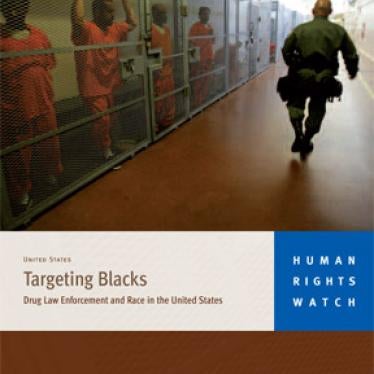It's become a depressingly predictable event. Every few months, the Bureau of Justice Statistics (BJS), a branch of the US Department of Justice, releases new figures showing that the US prison and jail population has grown yet again and has reached a new all-time high. The latest statistics, released last week, show that as of June 30, 2008, more than 2.3 million people were behind bars in this country -- an increase of almost 20 percent just since 2000. This gives the United States an incarceration rate of 762 per 100,000 residents -- the highest rate in the world, dwarfing those of other democracies like Great Britain (152 per 100,000), Canada (116), and Japan (63).
Of course incarceration doesn't affect everyone equally. Black men in the United States are 6.6 times more likely than white men to be incarcerated. More than 10 percent of all black males ages 25 to 39 were in prison or jail as of June 30, 2008. And a 2006 BJS study showed that prisons and jails have become the new asylums, with more than half of all prisoners suffering from mental health problems like major depression and psychotic disorders.
It wasn't always like this. For much of the 20th century, the US incarceration rate remained fairly stable. It began to climb sharply in the late 1970s, as a result of policy changes like mandatory minimum sentencing and the widespread abolition of parole. In the 1980s and 1990s, the "war on drugs" and "three strikes" laws fueled further growth. More people were going to prison, and staying there for longer periods of time. By 2004, the incarcerated population was six times what it had been in 1972.
Contrary to popular belief, the growing prison population has little or nothing to do with an increase in crime. In fact, crime rates fell steadily between 1991 and 2006, eventually reaching levels not seen since the 1960s. Yet the incarceration rate increased by more than 50 percent in that same period. It's clear, then, that political choice, not crime, has given the United States its massive prison and jail population.
Indeed, even within the United States, not all states have chosen the same path. Louisiana, the state with the highest incarceration rate, locks up more than six times as many of its residents on a per capita basis as Maine. Even neighboring states can differ dramatically - Wisconsin imprisons people at twice the rate of Minnesota, and Arizona's rate is more than double Utah's. These state-by-state differences make clear that there is nothing natural or inevitable about high incarceration rates. They are the result of specific policy choices, and those policies can be changed.
There are signs that change may be on the way. Sen. Jim Webb (D-VA), long a critic of America's love affair with incarceration, has called the US criminal justice system "a national disgrace" and urged "a major nationwide recalculation of who goes to prison and for how long." On March 26, he led a bipartisan group of Senators in introducing the National Criminal Justice Commission Act of 2009. The bill would create a blue-ribbon commission to conduct a comprehensive review of the criminal justice system, and make recommendations for changes in policies and laws to "reduce the overall incarceration rate while preserving public safety, cost-effectiveness, and societal fairness."
Our dysfunctional criminal justice system has been a long time in the making, and no one should have any illusions that it will be fixed overnight. But a National Criminal Justice Commission would be an important first step toward ending our shameful status as the world's leading prison nation.







